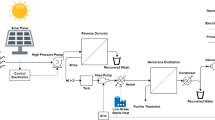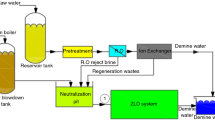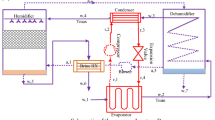Abstract
Nowadays, the freshwater is one of the most critical issues for humans. In this regard, desalination systems can be beneficial. In this research, at first different types of desalination systems and their governing equations is studied. Then the energy consumption of evaporative vacuum easy desalination system with brine tank is modeled. This modeling and the equations governing the energy consumption of new subsets such as the evaporator, condenser, vacuum pump, and other pumps are presented. In the end, the economic modeling of the system is investigated. The feasibility of using the system is reported in three cities (Abu Dhabi, Las Palmas, and Perth). The results shown that the annual operating cost of the pumps is estimated to be 0.19 M€ yr−1, 0.51 M€ yr−1 and 0.14 M€ yr−1 for Abu Dhabi and Las Palmas and Perth respectively. Also, the annual cost of fresh water production is compared with other reaches in these cities. The results are shown that Perth has the lowest cost of the fresh water output at 0.67 M€ yr−1 and Las Palmas has the highest cost of fresh water production with 0.104 M€ yr−1. The reason is the difference in the electricity prices in these cities.




Similar content being viewed by others
Abbreviations
- A :
-
Active surface of the heat transfer (m2)
- C f :
-
Heat capacity of feed water (J kg−1 K−1)
- C p :
-
Heat capacity of the water at constant pressure (J kg−1 K−1)
- C pl :
-
Heat capacity of saturated water (J kg−1 K−1)
- C pd :
-
Heat capacity of distillated water (J kg−1 K−1)
- C MED :
-
Cost of MED (€)
- C cond :
-
Cost of condenser (€)
- E :
-
Energy need to provide hot water (w)
- G :
-
Gravity (m/s2)
- H :
-
Average heat transfer coefficient (w M−2 k−1)
- H b :
-
Enthalpy of brine (J kg−1)
- H t :
-
Enthalpy of tank water (J kg−1)
- H f :
-
Enthalpy of feed water (J kg−1)
- H fg :
-
Heat of evaporation (J kg−1)
- H fg2 :
-
Heat capacity of the water condensation (J kg−1)
- H fgg :
-
Corrected value of the special water heat capacity (J kg−1)
- Ja:
-
Jacobin coefficient
- K l :
-
Temperature conductivity in saturated liquid state (W m−1 K−1)
- L :
-
Length (m)
- M 0b :
-
Brine flow rate (L h−1)
- M 0c :
-
Cooling water flow rate (L h−1)
- M 0f :
-
Feed water flow rate (L h−1)
- M 0h :
-
Heating water flow rate (L h−1)
- Mna-cl :
-
Mass of salt (g)
- M T :
-
Tank flow (L)
- AOClab :
-
Annual operative cost of labor
- AOCheating-fluid :
-
Annual operative cost of heating fluid (€ yr−1)
- TAC:
-
Total annual cost (€ yr−1)
- Q :
-
Heat exchanged (J s−1)
- S :
-
Salinity (g L−1)
- T ambient :
-
Temperature of ambient (°C)
- T h :
-
Temperature of heating water (°C)
- T b :
-
Temperature of brine (°C)
- T f :
-
Temperature of feed water (°C)
- T s :
-
Temperature of surface (°C)
- T sat :
-
Temperature of saturation (°C)
- \(\rho l\) :
-
Density at saturated liquid (kg m−3)
- \(\rho v\) :
-
Density at saturated vapor (kg m−3)
- \(\mu l\) :
-
Dynamic viscosity at saturated liquid (Pa s)
- \(\Delta {\text{TLMTD}}\) :
-
Logarithmic temperature difference (°C)
References
El-Dessouky H, Alatiqi I, Bingulac S, Ettouney H. Steady-state analysis of the multiple effect evaporation desalination process. Chem Eng Technol Ind Chem Plant Equip Process Eng Biotechnol. 1998;21(5):437–51.
Ali MB, Kairouani L. Multi-objective optimization of operating parameters of a MSF-BR desalination plant using solver optimization tool of Matlab software. Desalination. 2016;381:71–83.
Malik SN, Bahri PA, Vu LT. Steady state optimization of design and operation of desalination systems using Aspen Custom Modeler. Comput Chem Eng. 2016;91:247–56.
Bandi CS, Uppaluri R, Kumar A. Global optimization of MSF seawater desalination processes. Desalination. 2016;394:30–43.
Rautenbach R. Progress in distillation. Desalination. 1993;93(1–3):1–13.
Morin OJ. Design and operating comparison of MSF and MED systems. Desalination. 1993;93(1–3):69–109.
Mousapour A, Hajipour A, Rashidi MM, Freidoonimehr N. Performance evaluation of an irreversible Miller cycle comparing FTT (finite-time thermodynamics) analysis and ANN (artificial neural network) prediction. Energy. 2016;94:100–9.
Rashidi MM, Parsa AB, Shamekhi L, Nazari F, Ali M. Exergetic optimisation of a multi-stage compression transcritical refrigeration cycle. Int J Exergy. 2016;20(1):22–47.
Sheikholeslami M. Solidification of NEPCM under the effect of magnetic field in a porous thermal energy storage enclosure using CuO nanoparticles. J Mol Liq. 2018;263:303–15.
Sheikholeslami M. Numerical simulation for solidification in a LHTESS by means of Nano-enhanced PCM. J Taiwan Inst Chem Eng. 2018;86:25–41.
Sheikholeslami M. Finite element method for PCM solidification in existence of CuO nanoparticles. J Mol Liq. 2018;265:347–55.
Sheikholeslami M, Shamlooei M. Fe3O4–H2O nanofluid natural convection in presence of thermal radiation. Int J Hydrog Energy. 2017;42(9):5708–18.
Sheikholeslami M. Application of Darcy law for nanofluid flow in a porous cavity under the impact of Lorentz forces. J Mol Liq. 2018;266:495–503.
Sheikholeslami M, Ghasemi A. Solidification heat transfer of nanofluid in existence of thermal radiation by means of FEM. Int J Heat Mass Transf. 2018;123:418–31.
Sheikholeslami M. Numerical modeling of nano enhanced PCM solidification in an enclosure with metallic fin. J Mol Liq. 2018;259:424–38.
Sheikholeslami M, Zeeshan A. Analysis of flow and heat transfer in water based nanofluid due to magnetic field in a porous enclosure with constant heat flux using CVFEM. Comput Methods Appl Mech Eng. 2017;320:68–81.
Sheikholeslami M, Vajravelu K. Nanofluid flow and heat transfer in a cavity with variable magnetic field. Appl Math Comput. 2017;298:272–82.
Sheikholeslami M, Darzi M, Sadoughi MK. Heat transfer improvement and pressure drop during condensation of refrigerant-based nanofluid; an experimental procedure. Int J Heat Mass Transf. 2018;122:643–50.
Sheikholeslami M. Influence of magnetic field on Al2O3-H2O nanofluid forced convection heat transfer in a porous lid driven cavity with hot sphere obstacle by means of LBM. J Mol Liq. 2018;263:472–88.
Sheikholeslami M, Rokni HB. Melting heat transfer influence on nanofluid flow inside a cavity in existence of magnetic field. Int J Heat Mass Transf. 2017;114:517–26.
Sheikholeslami M, Sheremet MA, Shafee A, Li Z. CVFEM approach for EHD flow of nanofluid through porous medium within a wavy chamber under the impacts of radiation and moving walls. J Therm Anal Calorim. 2019;138(1):573–81. https://doi.org/10.1007/s10973-019-08235-3.
Farshad SA, Sheikholeslami M. Simulation of exergy loss of nanomaterial through a solar heat exchanger with insertion of multi-channel twisted tape. J Therm Anal Calorim. 2019;138(1):795–804. https://doi.org/10.1007/s10973-019-08156-1.
Javadi MA, Hoseinzadeh S, Khalaji M, Ghasemiasl R. Optimization and analysis of exergy, economic, and environmental of a combined cycle power plant. Sādhanā. 2019;44(5):121.
Javadi MA, Hoseinzadeh S, Ghasemiasl R, Heyns PS, Chamkha AJ. Sensitivity analysis of combined cycle parameters on exergy, economic, and environmental of a power plant. J Therm Anal Calorim. 2019; 1–7.
Hoseinzadeh S, Heyns PS, Chamkha AJ, Shirkhani A. Thermal analysis of porous fins enclosure with the comparison of analytical and numerical methods. J Therm Anal Calorim. 2019;138(1):727–35. https://doi.org/10.1007/s10973-019-08203-x.
Hoseinzadeh S, Moafi A, Shirkhani A, Chamkha AJ. Numerical validation heat transfer of rectangular cross-section porous fins. J Thermophys Heat Transf. 2019;33:698–704.
Hoseinzadeh S, Sahebi SAR, Ghasemiasl R, Majidian AR. Experimental analysis to improving thermosyphon (TPCT) thermal efficiency using nanoparticles/based fluids (water). Eur Phys J Plus. 2017;132(5):197.
Hoseinzadeh S. Thermal performance of electrochromic smart window with nanocomposite structure under different climates in Iran. Micro Nanosyst. 2019;11(2):154–64.
Hoseinzadeh S, Hadi Zakeri M, Shirkhani A, Chamkha AJ. Analysis of energy consumption improvements of a zero-energy building in a humid mountainous area. J Renew Sustain Energy. 2019;11(1):015103.
Hoseinzadeh S, Azadi R. Simulation and optimization of a solar-assisted heating and cooling system for a house in Northern of Iran. J Renew Sustain Energy. 2017;9(4):045101.
Yousef Nezhad ME, Hoseinzadeh S. Mathematical modelling and simulation of a solar water heater for an aviculture unit using MATLAB/SIMULINK. J Renew Sustain Energy. 2017;9(6):063702.
Yari A, Hosseinzadeh S, Golneshan AA, Ghasemiasl R. Numerical simulation for thermal design of a gas water heater with turbulent combined convection. In: ASME/JSME/KSME 2015 joint fluids engineering conference. American Society of Mechanical Engineers Digital Collection; 2015.
Gonda A, Lancereau P, Bandelier P, Luo L, Fan Y, Benezech S. Water falling film evaporation on a corrugated plate. Int J Therm Sci. 2014;81:29–37.
Elsafi AM. Integration of humidification-dehumidification desalination and concentrated photovoltaic-thermal collectors: energy and exergy-costing analysis. Desalination. 2017;424:17–26.
Olatayo KI, Wichers JH, Stoker PW. Energy and economic performance of small wind energy systems under different climatic conditions of South Africa. Renew Sustain Energy Rev. 2018;98:376–92.
Gu W, Wang X, Wang L, Yin X, Liu H. Performance investigation of an auto-tuning area ratio ejector for MED-TVC desalination system. Appl Therm Eng. 2019;155:470–9.
Serrano-Tovar T, Suárez BP, Musicki A, Juan A, Cabello V, Giampietro M. Structuring an integrated water-energy-food nexus assessment of a local wind energy desalination system for irrigation. Sci Total Environ. 2019;689:945–57.
Hu W, Liu Z, Tan J. Thermodynamic analysis of wind energy systems. In: Wind solar hybrid renewable energy system. IntechOpen; 2019.
Rosales-Asensio E, Borge-Diez D, Pérez-Hoyos A, Colmenar-Santos A. Reduction of water cost for an existing wind-energy-based desalination scheme: a preliminary configuration. Energy. 2019;167:548–60.
Mito MT, Ma X, Albuflasa H, Davies PA. Reverse osmosis (RO) membrane desalination driven by wind and solar photovoltaic (PV) energy: state of the art and challenges for large-scale implementation. Renew Sustain Energy Rev. 2019;112:669–85.
Agha KR. The thermal characteristics and economic analysis of a solar pond coupled low temperature multi stage desalination plant. Sol Energy. 2009;83(4):501–10.
El-Dessouky HT, Ettouney HM. Fundamentals of salt water desalination. Amsterdam: Elsevier; 2002.
Kaldellis JK, Kavadias KA, Kondili E. Renewable energy desalination plants for the Greek islands—technical and economic considerations. Desalination. 2004;170(2):187–203.
Kavvadias KC, Khamis I. The IAEA DEEP desalination economic model: a critical review. Desalination. 2010;257(1–3):150–7.
Nisan S, Dardour S. Economic evaluation of nuclear desalination systems. Desalination. 2007;205(1–3):231–42.
Ejli D, Benchrifa R, Bennouna A, Zazi K. Economic analysis of wind-powered desalination in the south of Morocco. Desalination. 2004;165:219–30.
Choi S, Kim B, Nayar KG, Yoon J, Al-Hammadi S, Han J, Al-Anzi B. Techno-economic analysis of ion concentration polarization desalination for high salinity desalination applications. Water Res. 2019;155:162–74.
Zou Q, Liu X. Economic effects analysis of seawater desalination in China with input–output technology. Desalination. 2016;380:18–28.
Filippini G, Al-Obaidi MA, Manenti F, Mujtaba IM. Design and economic evaluation of solar-powered hybrid multi effect and reverse osmosis system for seawater desalination. Desalination. 2019;465:114–25.
Boxman RL, Sanders DM, Martin PJ, editors. Handbook of vacuum arc science and technology: fundamentals and applications. Norwich: William Andrew; 1996.
Lewin G, Russell AM. Fundamentals of vacuum science and technology. Am J Phys. 1965;33:977.
Bergman TL, Incropera FP, DeWitt DP, Lavine AS. Fundamentals of heat and mass transfer. New York: Wiley; 2011.
Author information
Authors and Affiliations
Corresponding author
Additional information
Publisher's Note
Springer Nature remains neutral with regard to jurisdictional claims in published maps and institutional affiliations.
Rights and permissions
About this article
Cite this article
Kariman, H., Hoseinzadeh, S., Shirkhani, A. et al. Energy and economic analysis of evaporative vacuum easy desalination system with brine tank. J Therm Anal Calorim 140, 1935–1944 (2020). https://doi.org/10.1007/s10973-019-08945-8
Received:
Accepted:
Published:
Issue Date:
DOI: https://doi.org/10.1007/s10973-019-08945-8




